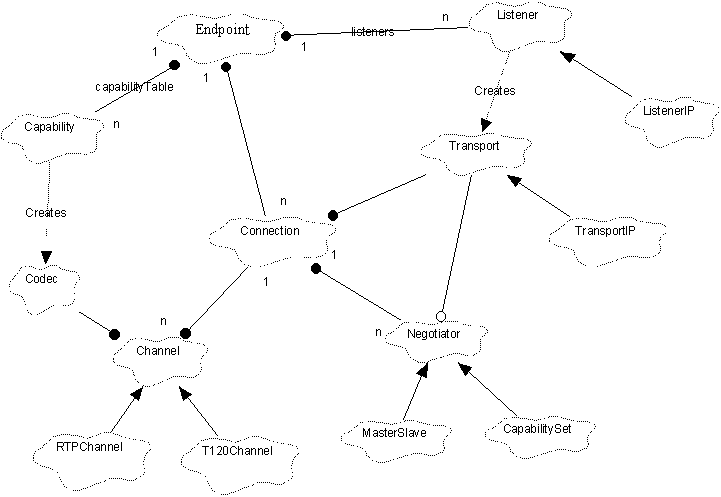
This document is provided to give an overview of the main classes present in the OpenH323 library and how they interact in the classic "phone" application. WARNING: As for most of the library, this document is a work in progress. At any given moment in time its resemblance to reality may be poor!
Below is a much-simplified Booch Class Diagram of the system:

The fundamental object of the ownership hierarchy is of the H323Endpoint class. An application would typically have one instance of a descendant of this class. The application defined descendant would set up defaults for various H323 parameters (timeouts etc), the most important of which is the capability table which defines the codecs and channel types the application is capable of handling.
Also created by the application in the H323Endpoint would be instances of one or more descendants of the H323Listener class. There is a descendant of this class for each protocol that is supported. For example H323ListenerIP would be for Internet use. Each listener spawns a thread that monitors its protocol and when a new incoming call is detected, creates an instance of a H323Transport class descendent. As for the H323Listener class, there is a descendent for each protocol supported, eg H323TransportIP.
When the first PDU arrives on a H323Transport using the Q.931 and H.225 protocols, there is a call reference that identifies the connection that has been made. These connections are embodied by the H323Connection class, which contains all of the state information for a connection between H323 endpoints. The H323Endpoint instance keeps track of these active connections. If there is no connection for the call reference number already, a new one is created and H323 signalling negotiations begun.
An application would often have the system create an instance of a descendant of the H323Connection class, rather than that class itself. This is so that any of a large number of virtual methods may be overridden. These virtual methods are "callback" functions by the library to allow the application to either obtain information or modify the behaviour at various phases of the protocol negotiations. For example, there is a callback for when an incoming call is in progress and the application user should be "alerted". This is highly application specific being anything from a simple audible beep to displaying a pop up window with bells and whistles.
The H323Negotiator classes are used to maintain the state and functionality of each command or variable defined by the H.245 protocol. Their main reason for existence is actually to reduce the scope of the h225.h and h245.h files, which define many hundreds of classes. A user of the H323Connection class thus does not have to include all of these classes on every compilation unit.
During some of the H.245 negotiations, logical channels may be created, both by the remote endpoint and by the local application. The H323Channel class descendants represents this. A typical use of one of these classes is to open a stream of encoded audio data. The H323Channel class would create a H323Codec using the H323Capability that was passed during the protocol negotiations.